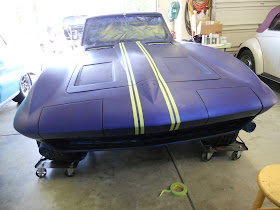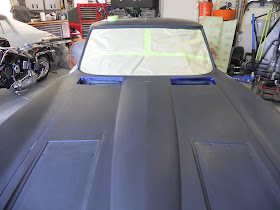Layout begins with finding the center of the car. Several measurements were taken over the length of the car then double checked with an eyeball and a thumb. Over the last couple years I've collected several examples of 1963 racing stripes. I printed these and used them for inspiration. I decided to use a 6" center stripe bordered by 1/2" stripes.
The stripe width will remain constant from below the front grill all the way to the rear valance. It will not taper. It was after 1963 when tapered stripes became popular.
I used Tape & Drape plastic sheeting from Sherwin-Williams to protect the car from overspray.
Just before paint is applied I like to burnish the green masking tape with the edge of a credit card. This helps insure a tight bond preventing bleed through. I also wipe the surface with a post sanding solution to remove all finger prints, sweat, dust, etc.
Three medium coats of silver metallic paint were applied. An interesting characteristic of metallic paint is it can't be sanded or scuffed otherwise it will scratch. That poses a problem because I'll want to scuff the stripe before I apply more Kandy. The fix is Intercoat Clear, a clear coat typically used to cover graphics. Two medium coats of Intercoat Clear were applied over the metallic while it was still tacky. I'll be able to scuff the Intercoat Clear without any issues.
Looks good to me.
Now the fun begins.
Whoo hoo...
My goodness...
The bright blue and the silver racing stripe will become a lot darker when I apply the final coats of Kandy Kobalt Blue. The racing stripe will become ghosted.
The racing stripe was fun. I enjoyed it and I like the results.
Thanks for watching.



















































